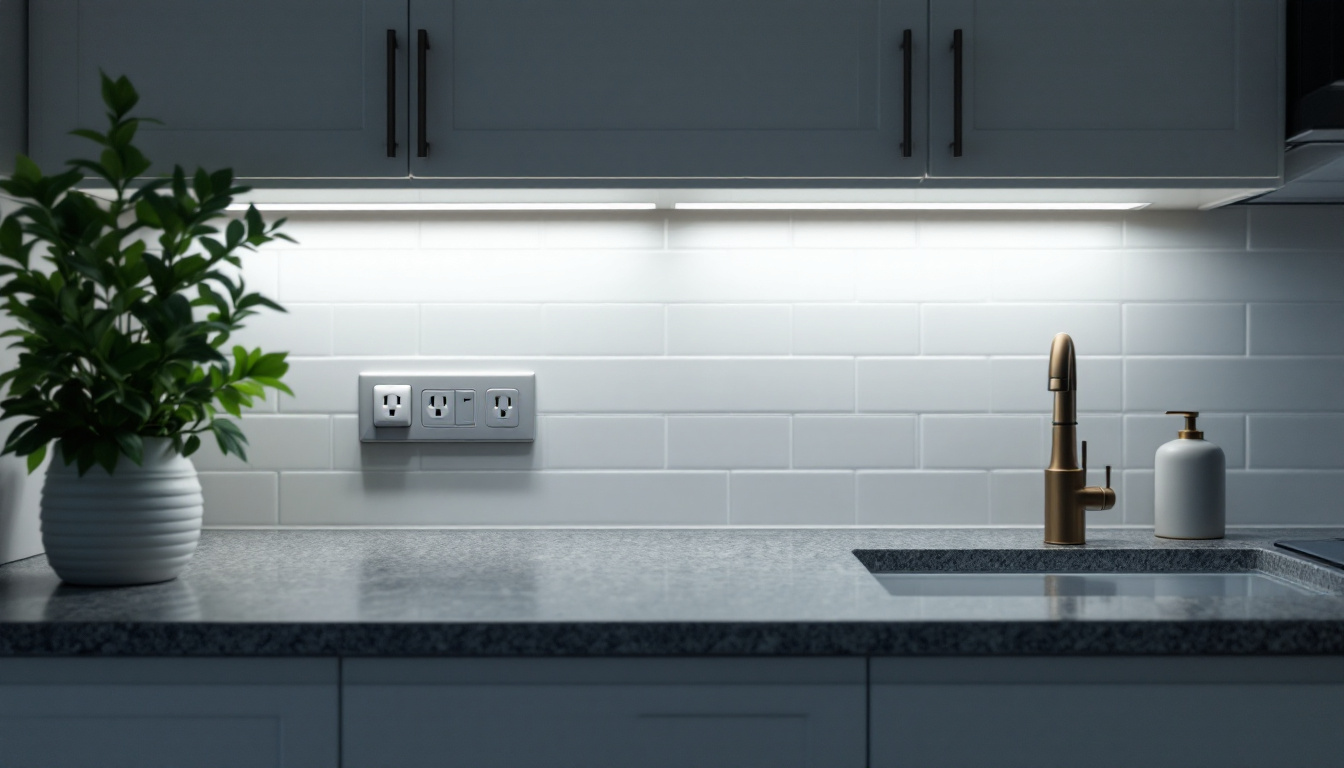

Under cabinet lighting and outlets have become essential components in modern kitchen and workspace design. As lighting contractors, understanding the nuances of these installations can help enhance both functionality and aesthetics for clients. This article addresses common questions that arise in the field, providing insights and guidance for lighting contractors.
Under cabinet lighting refers to fixtures installed beneath kitchen cabinets or shelves, illuminating countertops and workspaces. This type of lighting is crucial for enhancing visibility while cooking, preparing food, or performing other tasks. It can also create a warm ambiance, making the kitchen a more inviting space. The strategic placement of these lights not only serves a functional purpose but also adds a layer of aesthetic appeal, transforming the kitchen into a focal point of the home.
Typically, under cabinet lights come in various forms, including LED strips, puck lights, and fluorescent tubes. The choice of lighting can significantly affect the overall look and functionality of the kitchen. Therefore, it is essential for contractors to understand the different options available and their respective benefits. For instance, the color temperature of the lighting can influence the mood of the space; warmer tones can create a cozy atmosphere, while cooler tones can provide a more modern, crisp feel. Additionally, dimmable options allow for flexibility in lighting intensity, catering to different activities and times of day.
One of the primary advantages of under cabinet lighting is improved task visibility. By providing direct light where it is needed most, these fixtures help reduce shadows and enhance safety while working in the kitchen. Additionally, under cabinet lights can highlight beautiful countertops, backsplashes, and other design elements. This not only elevates the kitchen’s aesthetic but also showcases the homeowner’s personal style and investment in high-quality materials.
Furthermore, under cabinet lighting can contribute to energy efficiency. LED options, in particular, consume less power and have a longer lifespan compared to traditional bulbs. This not only saves on energy costs but also reduces the frequency of replacements, making it a practical choice for homeowners. Moreover, the ability to install motion sensors or smart controls can further enhance energy savings by ensuring that lights are only on when needed. This integration of technology not only promotes sustainability but also adds convenience to everyday kitchen tasks.
When selecting under cabinet lighting, contractors often encounter several common types, each with unique characteristics. LED strip lights are popular for their versatility and ease of installation. They can be cut to fit various lengths and come with adhesive backing for straightforward mounting. Their slim profile allows them to be discreetly placed, ensuring that the focus remains on the workspace rather than the fixtures themselves.
Puck lights, on the other hand, are small, round fixtures that can be placed strategically to provide focused lighting. They are ideal for highlighting specific areas, such as a cutting board or a decorative feature. Their ability to be installed in tight spaces makes them a favorite among homeowners looking to maximize illumination without overwhelming the design. Fluorescent lights remain a traditional choice, offering a broad spread of light but may be less energy-efficient than newer technologies. Despite this, they can still be effective in larger kitchens where extensive coverage is necessary. Additionally, some homeowners opt for a combination of different types of under cabinet lighting to achieve a layered lighting effect, enhancing both functionality and style in their kitchens.
Proper height and placement of under cabinet lighting are crucial for achieving optimal illumination. Generally, fixtures should be installed 2 to 4 inches from the front edge of the cabinet. This positioning ensures that the light effectively illuminates the countertop without creating glare or shadows.
Additionally, contractors should consider the height of the cabinets and the tasks that will be performed below them. For example, if the countertop is used for intricate tasks like baking or food preparation, more focused lighting may be necessary. It’s also worth noting that the type of light fixture can influence the effectiveness of the illumination. LED strip lights, for instance, can provide a continuous line of light that minimizes shadows, whereas puck lights can be strategically placed to highlight specific areas, such as a cutting board or a recipe book. The choice between these options should align with both aesthetic preferences and functional needs, ensuring that the kitchen remains a practical workspace.
Wiring under cabinet lighting requires careful planning to ensure safety and functionality. Contractors should assess the existing electrical system to determine if it can support the additional load. It may be necessary to install a dedicated circuit for larger lighting setups.
Moreover, the choice of power supply is vital. Some under cabinet lights operate on low voltage, requiring a transformer. Understanding the specific requirements of the selected fixtures will help avoid complications during installation. It’s also important to consider the location of outlets and switches to facilitate easy access. For instance, placing outlets in the cabinetry can help keep cords hidden and maintain a clean aesthetic. Additionally, using wire management solutions can prevent clutter and ensure that the installation remains tidy and professional-looking. This attention to detail not only enhances the functionality of the lighting but also contributes to the overall design of the kitchen.
Choosing the right switching options can enhance the user experience. Contractors should consider installing dimmer switches, allowing homeowners to adjust the brightness based on their needs. Additionally, motion sensors can provide convenience, automatically turning lights on and off as someone enters or leaves the space.
Furthermore, smart home integration is becoming increasingly popular in modern kitchens. Homeowners may opt for smart switches or lighting systems that can be controlled via smartphone apps or voice commands. This technology not only adds a layer of convenience but also allows for customized lighting scenes that can be tailored to different activities, such as hosting dinner parties or enjoying a quiet evening at home. By incorporating these advanced switching options, contractors can significantly enhance the functionality and appeal of under cabinet lighting, making it a standout feature in the kitchen design.
Integrating outlets with under cabinet lighting can significantly enhance the functionality of a kitchen. Proper outlet placement allows for easy access to power for small appliances, chargers, and other devices. Contractors should consider the layout of the kitchen and the typical usage patterns when determining outlet locations.
In general, outlets should be placed within reach of the countertop, ideally no more than 24 inches apart. This ensures that homeowners can conveniently plug in appliances without having to stretch or reach excessively. Additionally, outlets should be placed away from water sources to comply with safety regulations.
When selecting outlets for under cabinet installations, contractors have several options. Standard duplex outlets are the most common choice, providing two receptacles for plugging in devices. However, GFCI (Ground Fault Circuit Interrupter) outlets are essential in areas where water is present, such as kitchens, to prevent electrical shock.
USB outlets have also gained popularity, allowing homeowners to charge devices without needing an adapter. These outlets can be particularly useful in kitchens where smartphones or tablets are often used for recipes or entertainment while cooking.
Adhering to electrical codes and safety standards is paramount when installing outlets. Contractors must ensure that all outlets are properly grounded and meet local code requirements. This includes maintaining appropriate distances from water sources and ensuring that GFCI outlets are installed where necessary.
Additionally, it is essential to educate clients about the importance of using outlets safely. This includes avoiding overloading circuits and using appliances according to manufacturer guidelines. Providing this information not only enhances safety but also fosters trust between contractors and clients.
Choosing the right color temperature for under cabinet lighting is crucial for achieving the desired ambiance. Generally, a color temperature of 2700K to 3000K is ideal for creating a warm, inviting atmosphere in kitchens. This range mimics the soft glow of incandescent bulbs, making it suitable for residential spaces.
For task-oriented areas, such as workspaces, a cooler color temperature of 3500K to 4000K may be more appropriate. This range provides a brighter, more focused light that enhances visibility for detailed tasks. Contractors should discuss these options with clients to determine their preferences and the intended use of the space.
Energy efficiency is a significant concern for many homeowners, making it essential for contractors to recommend best practices. Opting for LED lighting is one of the most effective ways to enhance energy efficiency. LEDs consume significantly less energy than traditional bulbs and have a longer lifespan, resulting in lower replacement costs.
Additionally, incorporating dimmers and motion sensors can further improve energy efficiency. Dimmers allow homeowners to adjust lighting levels based on their needs, while motion sensors ensure that lights are only on when the space is occupied. Educating clients about these options can lead to more sustainable choices.
Even with careful planning and installation, issues may arise with under cabinet lighting. Common problems include flickering lights, dead bulbs, and inconsistent brightness. Contractors should be prepared to troubleshoot these issues effectively.
For flickering lights, checking the connections and ensuring that the fixtures are securely mounted can often resolve the problem. If a bulb is dead, replacing it with a compatible option is typically straightforward. Inconsistent brightness may require examining the wiring and power supply to ensure everything is functioning correctly.
Under cabinet lighting and outlets play a vital role in enhancing both the functionality and aesthetics of modern kitchens and workspaces. As lighting contractors, understanding the common questions and concerns surrounding these installations can lead to better service and satisfied clients.
From selecting the right fixtures to ensuring code compliance and safety, attention to detail is essential. By staying informed about the latest trends and technologies, contractors can provide valuable insights to homeowners, helping them create spaces that are not only beautiful but also practical.
Ultimately, the goal is to illuminate spaces effectively while integrating outlets in a way that enhances usability. By addressing the common questions outlined in this article, lighting contractors can navigate the complexities of under cabinet lighting and outlets with confidence.
Ready to elevate your lighting projects with the best in under cabinet lighting and outlets? Look no further than LumenWholesale, where we provide contractors with high-quality, spec-grade lighting solutions at unbeatable wholesale prices. Our extensive selection is designed to meet the highest industry standards, ensuring you deliver reliable and high-performance lighting to your clients. Plus, with free shipping on bulk orders, you can enjoy the convenience of premium lighting without hidden fees or compromises. Discover the ideal combination of quality, affordability, and convenience. Visit LumenWholesale today for Wholesale Lighting at the Best Value.

Discover the ultimate guide to mastering high bay lighting layouts with our comprehensive tool designed specifically for lighting contractors.

Discover the frequent pitfalls lighting contractors encounter with fluorescent bulb sizes.

Discover the key factors that distinguish top lighting contractors when it comes to installing LED light fixtures for drop ceilings.

Discover why purchasing outdoor lighting in bulk from local distributors might not be the best choice.
Get notified when NEW deals are released.
Optimize your budget with wholesale discounts.
Only top-quality, specification-grade lighting products.
No additional costs at checkout - what you see is what you pay.
We understand the unique needs of contractors.